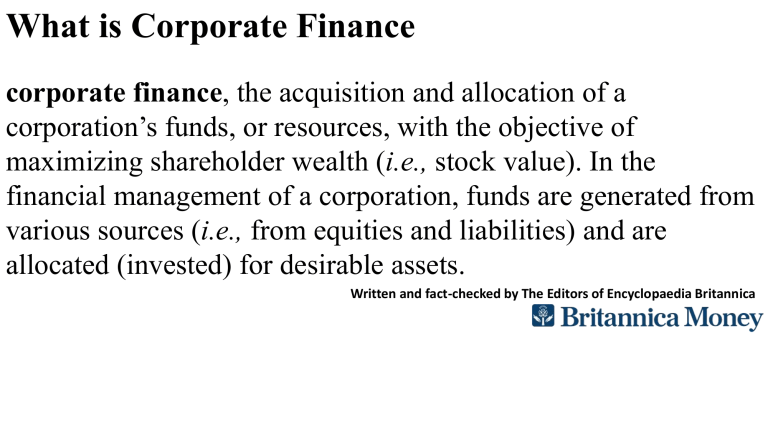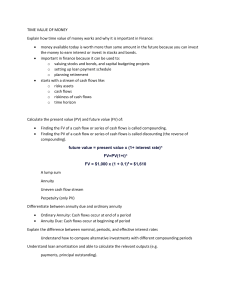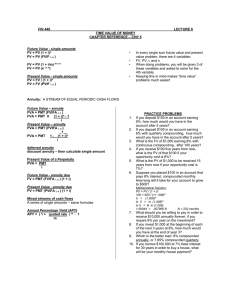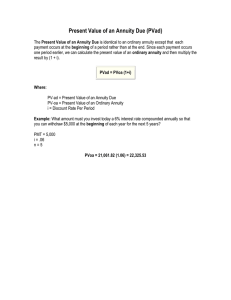
What is Corporate Finance
corporate finance, the acquisition and allocation of a
corporation’s funds, or resources, with the objective of
maximizing shareholder wealth (i.e., stock value). In the
financial management of a corporation, funds are generated from
various sources (i.e., from equities and liabilities) and are
allocated (invested) for desirable assets.
Written and fact-checked by The Editors of Encyclopaedia Britannica
The terms "corporate finance" and "corporate financier"
tend to be associated with transactions in which capital is
raised in order to create, develop, grow or acquire businesses.
Corporate finance refers to planning, developing and
controlling the capital structure of a business. It aims to
increase organizational value and profit through optimal
decisions on investments, finances as well as dividends. It
focusses on capital investments aimed at meeting the funding
requirements of a business to attain a favorable capital
structure.
Corporate finance deals with the capital structure of a
corporation, including its funding and the actions that
management takes to increase the value of the company.
Corporate finance also includes the tools and analysis utilized
to prioritize and distribute financial resources.
Corporate Finance-12e-Ross, Westerfield, Jaffe, Jordan
Corporate Finance-12e-Ross, Westerfield, Jaffe, Jordan
According to the balance sheet model finance can be
thought of as answering the following questions,
• in what long-lived assets should the firm invest?
• how can the firm raise cash for the required capital
expenditure?
• how should short-term operating cash flows be
managed?
All the decisions made in a business has financial
implications, and any decision that involves the use of money
is a corporate financial decision
The basic principles remain the same, whether at large or small
businesses.
All businesses have to
invest their resources wisely
find the right kind and mix of financing to fund these
investments
return cash to the owners if there are not enough good
investments
• Corporate finance attempts to find the answers to the
following questions:
– What
investments should the business take on?
THE INVESTMENT DECISION (Capital Budgeting)
– How
can finance be obtained to pay for the required
investments?
THE FINANCE DECISION ( Capital Structure)
– Should
dividends be paid? If so, how much?
THE DIVIDEND DECISION (Distribution)
Corporate Finance & Financial Accounting
Corporate Finance
inherently forward-looking and based on cash flows.
Financial Accounting
historic in nature and focuses on profit rather than cash.
Corporate Finance & Management Accounting
Corporate Finance
concerned with raising funds and providing a return to investors.
Management Accounting
concerned with providing information to assist managers in
making decisions within the company.
Corporate Objectives
❑
❑
❑
❑
❑
❑
Leveraged buyout
A leveraged buyout is a financial strategy in which a group
of investors gain voting control of a firm and then liquidate
its assets in order to repay the loans used to purchase the
firm’s shares. How leveraged buyouts would be viewed by
the shareholder wealth maximization model compared to
the corporate wealth maximization model
Conglomerates
Conglomerates are firms that have diversified into
unrelated
fields.
How
would
a
policy
of
conglomeration be viewed by the shareholder wealth
maximization model compared to the corporate
wealth maximization model?
Agency & Corporate Governance
Managers do not always act in the best interest of their
shareholders, giving rise to what is called the ‘agency’
problem
Agency is most likely to be a problem when there is a divergence
of ownership and control, when the goals of management differ
from those of shareholders and when asymmetry of information
exists
Monitoring and performance-related benefits are two potential ways
to optimize managerial behavior and encourage ‘goal oriented’
Two Key Concepts in Corporate Finance
The fundamental concepts in helping managers to
value alternative choices are
Relationship between Risk and Return
Time Value of Money
Relationship between Risk and Return
This concept states that an investor or a company takes on more risk only
if higher return is offered in compensation.
Return refers to
• Financial rewards gained as a result of making an
investment.
• The nature of return depends on the form of the investment.
• A company that invests in fixed assets & business
operations expects return in the form of profit (measured
on before- interest, before-tax & an after- tax basis)& in the
form of increased cash flows.
Relationship between Risk and Return
Risk refers to
Possibility that actual return may be different from the expected return.
When Actual Return > Expected Return
This is a Welcome Occurrence.
When Actual Return < Expected Return
This is a Risky Investment
Investors, Companies & Financial Managers are more likely to be concerned
with
• Possibility that Actual Return < Expected Return
Investors & Companies demand higher expected return
Possibility of actual return being different from expected return increases.
Time Value of Money
Time value of money is relevant to both
Companies
Investors
In a wider context,
Anyone expecting to pay or receive money over a period of time.
Time value of money refers to the fact that
Value of money changes over time.
What is time value of money?
A rupee today is more valuable than a year hence.
Why ?
Present value
Single cash flow
Annuity
Future value
Single cash flow
Annuity
Compounding
is the way to determine the future value of a sum of money invested now.
⚫ FV
= PV(1 + r)t
FV = future value
⚫ PV = present value
⚫ r = period interest rate, expressed as a decimal
⚫ T = number of periods
⚫
Rs. 20 deposited for five years at an annual interest rate of 6% will have future
value of:
Compounding takes us forward from current value of an investment to its
future value.
Future Value as a General Growth Formula
⚫Suppose
your company expects to increase unit
sales of computer by 15% per year for the next 5
years. If you currently sell 3 million computers in
one year, how many computers do you expect to
sell in 5 years?
Discounting - way to determine the present value of future cash flows
⚫ How
much do I have to invest today to have some amount in
the future?
= PV(1 + r)t
⚫ Rearrange to solve for PV = FV / (1 + r)t
⚫ FV
⚫ When
we talk about discounting, we mean finding the present
value of some future amount.
⚫ When we talk about the “value” of something, we are talking
about the present value unless we specifically indicate that we
want the future value.
⚫Suppose
you need Rs.10,000 in one year for the
down payment on a new car. If you can earn 7%
annually, how much do you need to invest today?
want to begin saving for your daughter’s college
education and you estimate that she will need Rs.150,000
in 17 years. If you feel confident that you can earn 8%
per year, how much do you need to invest today?
⚫You
Annuities
A series of constant cash flows for a specified period of time
Ordinary annuity –
• The payment or receipt of cash flow at
the
end
of
each period
Annuity Due –
• The payment or receipt of cash flow at
of each period
the beginning
Future Value of an Ordinary Annuity
FVA = PMT [
n
{(1+i)
– 1} / i]
FVA - Future value of an annuity in n periods
PMT
- Annuity amount
i
- Rate of compounding interest per period
n
- Number of periods
How much would you have in 5 years if you deposit
Rs.5000 a year at the end of each year into an account
that pays 7% interest per year
FVA = PMT [
n
{(1+i)
– 1} / i]
Future Value of an Annuity Due
FVAD = PMT
n
{[(1+i)
– 1] / i} (1+i)
How much would you have in 10 years if you deposit Rs.1000
a year at the start of each year into an account that pays 4%
interest per year
Present value of an Ordinary Annuity
1 – [1/(1+i)n]
PVA = PMT
i
An investment will pay you Rs.100 at the end of each
year for 12 years. What is the value of this investment
today if the interest rate is 8% per year
Present Value of an Annuity Due
1PVAD = PMT
1
(1 + i)n
i
(1 + i)
An investment will pay you Rs 1000 at the start of each year
for 12 years. What is the value of this investment today if the
interest rate is 10% per year?
Aim of Financial Manager
While accountancy plays an important role within
corporate finance, the fundamental problem addressed by
corporate finance is economic, i.e. how best to allocate
the scarce resource of capital.
The aim of the Financial Manager is the optimal
allocation of the scarce resources available to them.
High level of interdependence existing between decision
areas should be evaluated by financial managers when
making decisions
Interrelationship between Investment, Financing &
Dividend Decisions
Company decides to take on a large number of attractive new
investment projects
corporate governance systems have
traditionally stressed
internal controls and financial reporting rather than external
legislation.
Financial manager can maximize a company’s market value
by making good investment, financing and dividend decisions
Enron Scandal (2001)
What happened: Shareholders lost $74 billion, thousands of
employees and investors lost their retirement accounts, and
many employees lost their jobs.
Penalties: former CEO died before serving time; CEO got 24
years in prison. The company filed for bankruptcy. Arthur
Andersen was found guilty of fudging Enron's accounts.
Fun fact:
Fortune Magazine named Enron "America's Most Innovative
Company" 6 years in a row prior to the scandal.





